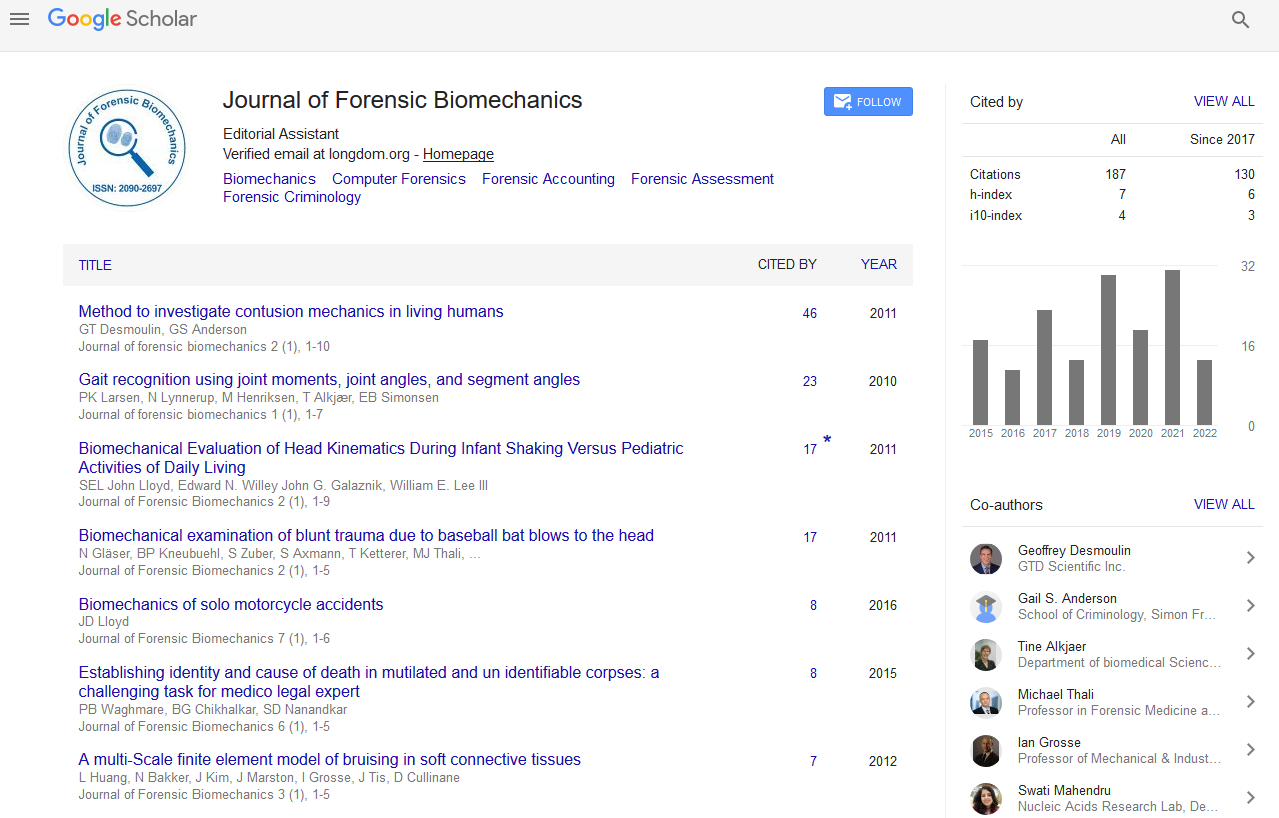Indexed In
- Genamics JournalSeek
- SafetyLit
- Ulrich's Periodicals Directory
- RefSeek
- Hamdard University
- EBSCO A-Z
- Geneva Foundation for Medical Education and Research
- Euro Pub
- Google Scholar
Useful Links
Share This Page
Journal Flyer

Open Access Journals
- Agri and Aquaculture
- Biochemistry
- Bioinformatics & Systems Biology
- Business & Management
- Chemistry
- Clinical Sciences
- Engineering
- Food & Nutrition
- General Science
- Genetics & Molecular Biology
- Immunology & Microbiology
- Medical Sciences
- Neuroscience & Psychology
- Nursing & Health Care
- Pharmaceutical Sciences
Short Communication - (2024) Volume 15, Issue 1
The Mechanics of Crime: Investigating with Forensic Biomechanics
Arthur Willam*Received: 01-Mar-2024, Manuscript No. JFB-24-25419; Editor assigned: 04-Mar-2024, Pre QC No. JFB-24-25419 (PQ); Reviewed: 18-Mar-2024, QC No. JFB-24-25419 ; Revised: 25-Mar-2024, Manuscript No. JFB-24-25419 (R); Published: 01-Apr-2024, DOI: 10.35248/2090-2697.24.15.479
Description
Forensic biomechanics stands at the intersection of human movement and forensic science, separating the ambiguities buried within the trajectories of objects, impacts, and the human body itself. In the empire of criminal investigations, understanding the complex dynamics of bodies in motion can often be the key to unlocking essential evidence and piecing together the events leading to a crime. "Bodies in Motion Discovering Forensic Biomechanics" delves into this absorbing field, break experienced on its methodologies, applications, and important role in modern forensic investigations. Forensic biomechanics employs principles from mechanics, physiology, and engineering to analyses anthropoid motion and the forces acting upon it. It investigates how the laws of physics manifest in real-world scenarios, offering invaluable insights into the dynamics of injury mechanisms, accident reconstruction, and the interpretation of evidence at crime scenes [1].
One of the primary applications of forensic biomechanics fabrications in reconstructing the events leading to traumatic injuries or fatalities. By methodically analyzing the forces involved in a collision, fall, or assault, forensic bio mechanists can reconstruct the sequence of events with remarkable precision. For instance, in cases of vehicular accidents, biomechanical analysis can determine the speed, direction, and point of impact, providing critical information for legal proceedings and insurance claims [2].
Furthermore, forensic biomechanics plays a pivotal role in understanding patterns of injury and their implications in criminal investigations [3]. By examining the mechanics of a gunshot wound, for example, experts can determine the distance from which the shot was fired or the angle at which the bullet entered the body. Such insights are invaluable in distinguishing between self-inflicted injuries, accidents, and homicides, aiding law enforcement agencies in their detection of justice [4].
Moreover, forensic biomechanics extends its reach beyond the realm of violent crimes, offering insights into a wide array of incidents, including slip-and-fall accidents, workplace injuries, and sports-related mishaps. By analyzing the biomechanics of falls, experts can assess factors such as surface friction, body posture, and impact velocity, helping to determine liability in civil lawsuits and insurance claims [5].
In addition to its applications in injury analysis and accident reconstruction, forensic biomechanics plays a key role in evaluating the reliability of eyewitness testimony and physical evidence. By subjecting witness accounts and forensic evidence to biomechanical analysis, experts can assess their consistency with the laws of physics and identify discrepancies or inconsistencies that may arise [6]. This approach not only enhances the credibility of evidence presented in court but also safeguards against wrongful convictions based on defective or disingenuous information [7].
Furthermore, advancements in technology have significantly expanded the capabilities of forensic biomechanics, enabling the development of sophisticated computer simulations and virtual reconstructions of crime scenes [8]. By integrating data from medical imaging, motion capture, and computational modelling, researchers can recreate complex scenarios with unprecedented accuracy, providing invaluable insights into the dynamics of human motion and interaction [9].
However, despite its undeniable potential, forensic biomechanics also faces several challenges and limitations. The interpretation of biomechanical data often requires an exact considerate of human anatomy, physiology, and mechanics, as well as access to specialized equipment and expertise. Moreover, the subjective nature of certain biomechanical analyses can lead to disparities in interpretation and conflicting expert opinions, posing challenges in the courtroom [10].
Conclusion
Exploring Forensic Biomechanics illuminates the multifaceted nature of this dynamic field, highlighting its applications, methodologies, and impact on modern forensic investigations. By separating the mysteries hidden within the trajectories of bodies in motion, forensic biomechanics not only enhances our understanding of injury mechanisms and accident reconstruction but also plays a key role in the pursuit of justice and the safeguarding of truth in the criminal justice system.
References
- Kaur G, Malhotra S. A hybrid approach for data hiding using cryptography schemes. 2013;4(8).
- Paar C, Pelzl J. Understanding cryptography: a textbook for students and practitioners. 2009.
- Luckett WM. Cellular automata for dynamic S-boxes in cryptography. 2007.
- Toorani M, Falahati A. A secure variant of the Hill cipher.2009;313-316.
- Saeednia S. How to make the hill cipher secure. Cryptologia. 2000;24(4):353-360.
- Lin CH, Lee CY, Lee CY. Comments on Saeednia's improved scheme for the Hill cipher. J Chin Inst Eng. 2004;27(5):743-746.
- Martínez-Ramos L, Mecate-Zambrano M, et al. How to repair the hill cipher. J Zhejiang Univ Sci. 2008;9(2):211-214.
- Thilaka B, Rajalakshmi K. An extension of hill cipher using generalised inverses and mth residue modulo n. Cryptologia. 2005;29(4):367-376.
- Gupta I, Singh J, Chaudhary R. Cryptanalysis of an extension of the hill cipher. Cryptologia. 2007;31(3):246-253.
- Biryukov A. Encyclopedia of cryptography and security. 2011.
Citation: Willam A (2024) The Mechanics of Crime: Investigating with Forensic Biomechanics. J Forensic Biomech. 15:479.
Copyright: © 2024 willam A. This is an open-access article distributed under the terms of the Creative Commons Attribution License, which permits unrestricted use, distribution, and reproduction in any medium, provided the original author and source are credited.

